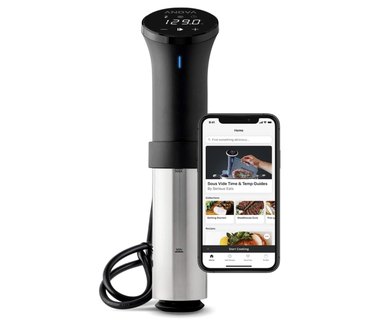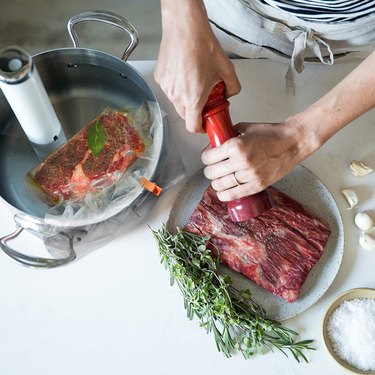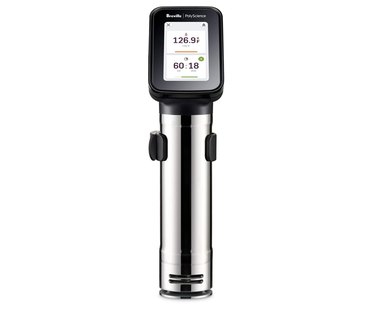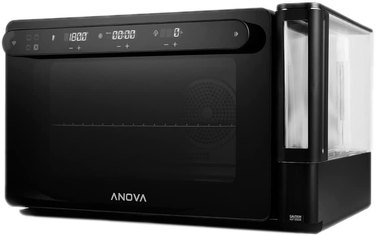
Cookery has its trends like anything else, and in the past decade, one of the big ones has been sous vide cooking. The term literally means "under vacuum" in French, though that's a pretty vague description. In practice, it means cooking foods in a water bath at a tightly controlled temperature, in a sealed and watertight bag (that's where the vacuum part comes in). Chefs were the first to make it a widespread cooking technique, but it spread to ordinary home cooks as the cost of sous vide machines dropped.
If you've been thinking about hopping onto the sous vide bandwagon, you'll need to know how the machines (and the cooking technique itself) work, and which are the best sous vide machines. Keep scrolling, and we'll explain it all.
Video of the Day
Video of the Day
What Is a Sous Vide Machine?
To be clear, you can cook sous vide without a machine. You just need a water bath and a way to heat the water with extreme accuracy and circulate it around your food. In practice, now that prices have dropped so far, it's usually easier (and often cheaper) to just purchase a sous vide machine.
To cook sous vide, you'd choose the finished temperature you want for a given dish—say, for example, 130 degrees Fahrenheit for a steak—and cook it at that exact temperature until it's heated all the way through. You can't overcook it, even if you're distracted by a phone call or crying child. It's much more logical than blasting that same steak on a grill, broiler or cast-iron skillet at over 400 degrees Fahrenheit, and hoping that you remove it from the heat at just the right moment. Long, slow sous vide cooking can even make the toughest cuts as tender as a filet mignon—a great budget-stretcher when prices are high.
It's a very different approach to cooking, though, so there's a bit of an adjustment period involved. Some common questions people have when they're starting with sous vide include:
Q: Is sous vide cooking food safe?
A: Sous vide cooking seems to violate some common rules of food safety, by keeping your food at relatively low temperatures (often below 140 degrees Fahrenheit, and technically in the "danger zone") for extended periods. In practice, you'll usually start each "cook" by either searing your cut before it's bagged or by dropping the bag briefly into boiling water to pasteurize it. Also, longer times at lower temperatures pasteurize just as effectively as shorter times at higher temperatures. As long as your recipe comes from a reputable source, it's fine.
Q: Do I need to buy a vacuum sealer?
A: No. A top-quality vacuum sealer is certainly handy to have, even if you don't cook sous vide, and many sous vide enthusiasts eventually buy one. Heavy-duty, zipper-seal bags work just fine, though. Squeeze out as much air as you can, seal the bag tightly, and you're good to go.
Q: How do you know when sous vide is done?
A: It's hard to know when a piece of food in your sous vide machine is done because you don't get the same smells or visual signals you're used to. You can open the bag and use a kitchen thermometer or simply cut into your meat to check, and then re-seal the bag if it needs to go back into the bath. Usually, though, the time-and-temperature guidelines on major sous vide sites like Chef Steps are well-tested and reliable.
Q: My steak won't get browned in sous vide, will it?
A: No, but it doesn't need to. You can either brown it before you sous vide it or cook it to a temperature slightly below your real target (5 or 10 degrees lower, depending on the thickness of the cut) and then sear it afterward, which will bring it the rest of the way to your chosen doneness.
What to Consider When Purchasing a Sous Vide Machine
A sous vide machine has to do just a few things: Bring a quantity of water to the desired temperature, hold it at that temperature with a high degree of accuracy, and run long enough (usually unattended) for your cooking time to be completed. Usually, you'll do that in a pot for small batches of food, though an insulated picnic cooler is better for big batches (your circulator won't have to work so hard to keep the temperature stable).
Extra features like Wi-Fi or Bluetooth connectivity, or a clip that will work for a cooler as well as a pot, are welcome but not core capabilities. Those core capabilities (the things you need to be looking at when you compare different models) include:
Power: The most popular models run around 1000 or 1100 watts, though compact units can be well below that and commercial units can be well above. As a rule, more is better because a more powerful unit can heat a larger volume of water (and enable bigger batches).
Accuracy and Temperature Range: A sous vide machine stands or falls on the accuracy of the temperature it can maintain. The better its accuracy, the more trustworthy and consistent its results will be. Some units can hold a lower or higher temperature than others, without sacrificing accuracy. That's a bonus and adds to the machine's versatility.
Flow Rate: Most sous vide machines are immersion circulators, which means they both heat and circulate the water (think of it as an aquarium's water circulator on steroids). The higher the flow rate, the larger the volume of water it can work with. That, in turn, means you can use a larger pot or even a picnic cooler for big-event cooking.
Style of the Machine: The original sous vide machines were insulated boxes rather like a picnic cooler, but with the heating and water-circulating hardware built-in. You'll still see those around, but immersion circulators—because of their compact size and minimal storage requirements—are far and away the most popular and account for most of our choices. In the past couple of years, some countertop ovens and induction cookers have become capable of sous vide cookery as well, and we'll touch on those in our roundup.
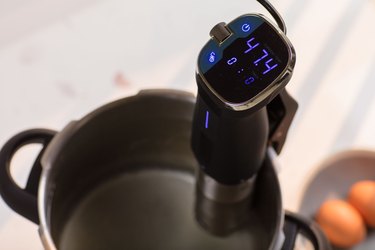
The Best Overall Sous Vide Machine
Anova Precision Cooker AN-500-US00
Anova Culinary has done a lot of the heavy lifting required to bring sous vide into the mainstream and is deservedly a standard-bearer for the technology. This model hits a sweet spot in the company's lineup, offering more power than the tiny Nano model but a more attractive price than the higher-end Pro model. It's smaller and easier to store than the earlier versions and can be operated by physical controls on the circulator itself or by using the Anova app, via Wi-Fi (there's also an Alexa skill). The app also includes access to a huge quantity of sous vide recipes: The company claims it's the world's largest collection, and they're probably right. Also, its clamp is adjustable enough to accommodate a picnic cooler as well as a pot. Bottom line? More people use this Anova sous vide machine than any other, and for good reason.
At a Glance:
- Power: 1000 watts
- Flow Rate: 8 liters/minute
- Temperature Range and Accuracy: Up to 197° F, +/- 0.2° F
- Connectivity: Wi-Fi
- Warranty: 2 years
The Best Compact Sous Vide Machine
Breville CS10001 Joule Sous Vide
The biggest rival to Anova's dominance in sous vide is physically its smallest rival: The Joule CS10001 (originally by Chef Steps, now owned by Breville). This slim, 11-inch cylinder is physically smaller than the Anova Nano but packs more power than our top-choice Anova Precision. If you have a small kitchen, the Joule is tiny enough to fit in any drawer. It matches the Anova with Wi-Fi connectivity and an Alexa skill, and beats it by adding Bluetooth connectivity as well. At roughly half the size, it's sleeker and downright elegant in appearance.
So why did the Anova score higher overall? Its clamp is sturdier and accommodates thicker containers (a bigger clip is sold separately); the Joule lacks the Anova's physical controls (so when connectivity is poor, cooking is difficult); and the Joule costs more. If those things aren't deal-breakers for you, the Joule is a perfectly legitimate number one choice in its own right.
At a Glance:
- Power: 1100 Watts
- Flow Rate: 10 liters/minute
- Temperature Range and Accuracy: Up to 208° F, +/- 0.2° F
- Connectivity: Wi-Fi, Bluetooth
- Warranty: 1 year
The Best Budget Sous Vide Machine
Wancle 1100 Watt Sous Vide Cooker
Wancle's earlier sous vide model earned good reviews, despite being lower-powered at 850 watts and having a relatively bulky design. This model, new for 2022, ticks all the right boxes: It's more powerful at 1100 watts, it's much more compact, and it also maintains its temperatures more accurately (to within 0.1 degrees Fahrenheit, rather than 1 degree Fahrenheit). The lack of Wi-Fi or Bluetooth connectivity will be a dealbreaker for some, but the Wancle offers excellent value for the dollar if you're looking for a no-frills model to help you (cough) "test the waters" of sous vide. You'll even get a recipe book, bags and a vacuum pump included with your purchase, so you're good to go as soon as your order arrives.
At a Glance:
- Power: 1100 watts
- Flow Rate: 8 liters/minute
- Temperature Range and Accuracy: Up to 194° F, +/- 0.1° F
- Connectivity: No
- Warranty: 1 year
The Best High-End Sous Vide Machine
PolyScience HydroPro Sous Vide Immersion Circulator
Years before Anova made sous vide a consumer technology, it was PolyScience (now owned by Breville) that made it a technology chefs could use in a commercial kitchen. This sleek and powerful unit is the current expression of that heritage, and it's an ideal upgrade for anyone who's already a sous vide convert and wants a commercial-quality machine. It packs 1450 watts of power for fast heating and has a superior flow rate of 17 liters per minute. Construction is "restaurant kitchen" solid, with a stainless steel body and a touchscreen display covered in Corning's Gorilla Glass (just like a smartphone). You won't get consumer-oriented features like wireless connectivity or an app, though much of an app's functionality is built into the unit itself (from data logging to storing recipe presets). This is a serious tool, for serious cooks.
At a Glance:
- Power: 1450 watts
- Flow Rate: 17 liters/minute
- Temperature Range and Accuracy: Up to 194° F, +/- 0.1° F
- Connectivity: No
- Warranty: 1 year
The Best Sous Vide Machine That's Not an Immersion Circulator
Anova Precision Smart Oven
If you're not a fan of having single-purpose appliances in your kitchen, the Anova Precision Smart Oven might be exactly what you're looking for. It's a better oven than your traditional oven, and it's also—in many ways—a better sous vide machine than a circulator. Commercial kitchens often rely on so-called "combi ovens" that combine regular convection baking with steam, and the Anova is that technology scaled down to fit on a home kitchen's countertop.
More to the point, it leverages Anova's expertise to provide sous vide cooking without bags. You could sear a steak in a pan and then finish it sous vide in the same pan, for example, or cook a whole chicken sous vide and then have the convection function kick in to crisp and brown the skin. It's not for everyone (it's a bit bulky) but it's a remarkably powerful tool. Like Anova's circulators, it has both Wi-Fi connectivity and physical controls, and you can use it with the company's app or Alexa skill.
At a Glance:
- Power: 1800 Watts
- Flow Rate: N/A
- Temperature Range and Accuracy: Up to 212° F, +/- 0.5° F (in sous vide mode)
- Connectivity: Wi-Fi
- Warranty: 2 years
Tip
If you're also thinking about buying a countertop induction cooker, a few leading models from companies like Max Burton, Hestan and PolyScience offer the kind of fine control you'd need to cook sous vide. For more details, see our article on induction cookers.
